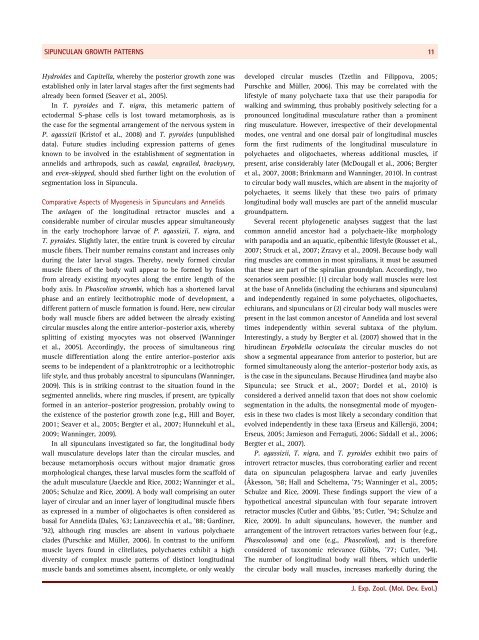PhD thesis - Biologisk Institut - Københavns Universitet
PhD thesis - Biologisk Institut - Københavns Universitet
PhD thesis - Biologisk Institut - Københavns Universitet
Create successful ePaper yourself
Turn your PDF publications into a flip-book with our unique Google optimized e-Paper software.
SIPUNCULAN GROWTH PATTERNS 11Hydroides and Capitella, whereby the posterior growth zone wasestablished only in later larval stages after the first segments hadalready been formed (Seaver et al., 2005).In T. pyroides and T. nigra, this metameric pattern ofectodermal S-phase cells is lost toward metamorphosis, as isthe case for the segmental arrangement of the nervous system inP. agassizii (Kristof et al., 2008) and T. pyroides (unpublisheddata). Future studies including expression patterns of genesknown to be involved in the establishment of segmentation inannelids and arthropods, such as caudal, engrailed, brachyury,and even-skipped, should shed further light on the evolution ofsegmentation loss in Sipuncula.Comparative Aspects of Myogenesis in Sipunculans and AnnelidsThe anlagen of the longitudinal retractor muscles and aconsiderable number of circular muscles appear simultaneouslyin the early trochophore larvae of P. agassizii, T. nigra, andT. pyroides. Slightly later, the entire trunk is covered by circularmuscle fibers. Their number remains constant and increases onlyduring the later larval stages. Thereby, newly formed circularmuscle fibers of the body wall appear to be formed by fissionfrom already existing myocytes along the entire length of thebody axis. In Phascolion strombi, which has a shortened larvalphase and an entirely lecithotrophic mode of development, adifferent pattern of muscle formation is found. Here, new circularbody wall muscle fibers are added between the already existingcircular muscles along the entire anterior–posterior axis, wherebysplitting of existing myocytes was not observed (Wanningeret al., 2005). Accordingly, the process of simultaneous ringmuscle differentiation along the entire anterior–posterior axisseems to be independent of a planktrotrophic or a lecithotrophiclife style, and thus probably ancestral to sipunculans (Wanninger,2009). This is in striking contrast to the situation found in thesegmented annelids, where ring muscles, if present, are typicallyformed in an anterior–posterior progression, probably owing tothe existence of the posterior growth zone (e.g., Hill and Boyer,2001; Seaver et al., 2005; Bergter et al., 2007; Hunnekuhl et al.,2009; Wanninger, 2009).In all sipunculans investigated so far, the longitudinal bodywall musculature develops later than the circular muscles, andbecause metamorphosis occurs without major dramatic grossmorphological changes, these larval muscles form the scaffold ofthe adult musculature (Jaeckle and Rice, 2002; Wanninger et al.,2005; Schulze and Rice, 2009). A body wall comprising an outerlayer of circular and an inner layer of longitudinal muscle fibersas expressed in a number of oligochaetes is often considered asbasal for Annelida (Dales, ’63; Lanzavecchia et al., ’88; Gardiner,’92), although ring muscles are absent in various polychaeteclades (Purschke and Müller, 2006). In contrast to the uniformmuscle layers found in clitellates, polychaetes exhibit a highdiversity of complex muscle patterns of distinct longitudinalmuscle bands and sometimes absent, incomplete, or only weaklydeveloped circular muscles (Tzetlin and Filippova, 2005;Purschke and Müller, 2006). This may be correlated with thelifestyle of many polychaete taxa that use their parapodia forwalking and swimming, thus probably positively selecting for apronounced longitudinal musculature rather than a prominentring musculature. However, irrespective of their developmentalmodes, one ventral and one dorsal pair of longitudinal musclesform the first rudiments of the longitudinal musculature inpolychaetes and oligochaetes, whereas additional muscles, ifpresent, arise considerably later (McDougall et al., 2006; Bergteret al., 2007, 2008; Brinkmann and Wanninger, 2010). In contrastto circular body wall muscles, which are absent in the majority ofpolychaetes, it seems likely that these two pairs of primarylongitudinal body wall muscles are part of the annelid musculargroundpattern.Several recent phylogenetic analyses suggest that the lastcommon annelid ancestor had a polychaete-like morphologywith parapodia and an aquatic, epibenthic lifestyle (Rousset et al.,2007; Struck et al., 2007; Zrzavy et al., 2009). Because body wallring muscles are common in most spiralians, it must be assumedthat these are part of the spiralian groundplan. Accordingly, twoscenarios seem possible: (1) circular body wall muscles were lostat the base of Annelida (including the echiurans and sipunculans)and independently regained in some polychaetes, oligochaetes,echiurans, and sipunculans or (2) circular body wall muscles werepresent in the last common ancestor of Annelida and lost severaltimes independently within several subtaxa of the phylum.Interestingly, a study by Bergter et al. (2007) showed that in thehirudinean Erpobdella octoculata the circular muscles do notshow a segmental appearance from anterior to posterior, but areformed simultaneously along the anterior–posterior body axis, asis the case in the sipunculans. Because Hirudinea (and maybe alsoSipuncula; see Struck et al., 2007; Dordel et al., 2010) isconsidered a derived annelid taxon that does not show coelomicsegmentation in the adults, the nonsegmental mode of myogenesisin these two clades is most likely a secondary condition thatevolved independently in these taxa (Erseus and Källersjö, 2004;Erseus, 2005; Jamieson and Ferraguti, 2006; Siddall et al., 2006;Bergter et al., 2007).P. agassizii, T. nigra, andT. pyroides exhibit two pairs ofintrovert retractor muscles, thus corroborating earlier and recentdata on sipunculan pelagosphera larvae and early juveniles(Åkesson, ’58; Hall and Scheltema, ’75; Wanninger et al., 2005;Schulze and Rice, 2009). These findings support the view of ahypothetical ancestral sipunculan with four separate introvertretractor muscles (Cutler and Gibbs, ’85; Cutler, ’94; Schulze andRice, 2009). In adult sipunculans, however, the number andarrangement of the introvert retractors varies between four (e.g.,Phascolosoma) and one (e.g., Phascolion), and is thereforeconsidered of taxonomic relevance (Gibbs, ’77; Cutler, ’94).The number of longitudinal body wall fibers, which underliethe circular body wall muscles, increases markedly during theJ. Exp. Zool. (Mol. Dev. Evol.)
















